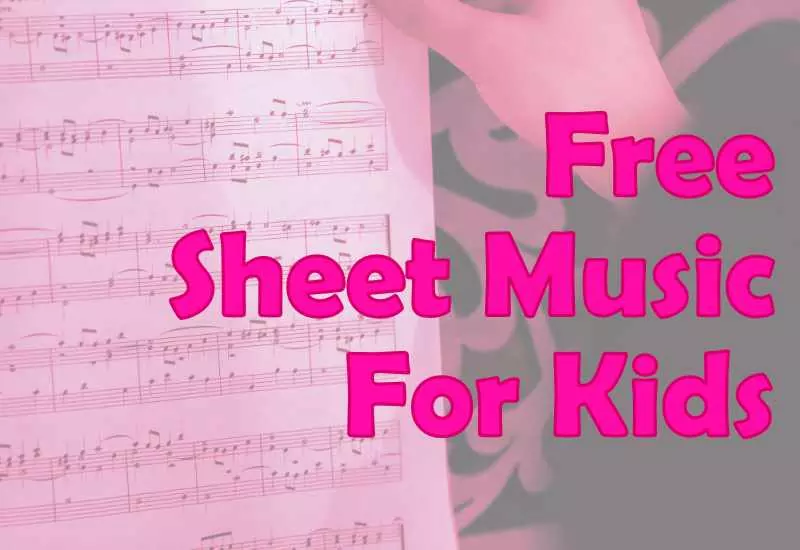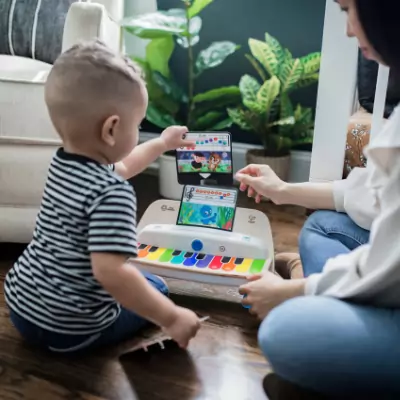Free Sheet Music for Kids

Contents
Getting Started in Your Child’s Piano Lessons
If you are a parent thinking of getting your child started on playing musical instruments like the piano, or wanting to give the primary lessons yourself, we made you a simple guide with some free sheet music for kids to get you on the road.
How early can we start with the lessons?
Mozart started learning the piano basics at the age of three.
It’s true that the younger the children are, the bigger the head start they have in any field of mastery, like in playing musical instruments. Children can start learning to play musical instruments as soon as they can understand and perform instructions.
For music teachers, ages 6-8 years old are perfect because, during this time, children are more teachable, which means they can concentrate long enough for the duration of the lesson. At this age, children are like sponges, learning everything easily in whatever they are exposed to.
As parents, you would probably start thinking of piano lessons for your children once they start showing signs of interest. The earlier they show interest, the faster you should start cultivating it by giving them formal lessons whether by hiring a music teacher or training them yourself.
There is no definitive age for learning. In other words, play it by ear, and you will be the judge of whether your child is ready to train in music.
What are the basic skills in playing the piano?
In the formative years of children, it is crucial to develop in them skills that will become the foundation of playing the piano or any instrument or craft for that matter.
On technical skills for piano playing, the learner has to memorize the notes and associate these with the piano keys, to strengthen the fingers, and to build hand coordination. Let’s talk about these three skills:
Memorize notes
- Note naming is the first step in reading sheet music. Without establishing this from the get-go, a sheet will not make sense to the learner and it will be harder to move to more challenging and complex sheets. The training on notes should be well-tied up with the instrument. Beginners learn faster if they can experience (feel and hear) the note on the instrument rather than just concentrating on memorizing symbols on the paper.
Strengthen the fingers
- The fingers should get used to the sensation of pressing the piano keys. At the same time, it pays to build the dexterity, strength, and control of their little fingers, hands, and wrists. One problem with learning piano late in life is that not all fingers are strong enough, for example, the pinkies. Younger children have the advantage of training their fingers for strength so it should be given as much thought in formal lessons. There are also some hand stretches you can find online.
Exercise hand coordination
- There must be an exercise for hand coordination separate from reading sheets. Usually, it’s easier to begin practicing hand independence, but once the learner moves to songs that require both hands, it will become a feat. Having them start playing with both hands in the first weeks will lessen this difficulty than if they get too comfortable playing with hand independence for too long.
These are only a few of the fundamental skills in piano playing, but there are certainly more depending on the music teacher and the kind of training they provide. After these basic skills are improved, beginners can move on to beat, pitch, scale patterns, and so on as they progress to more details in sheet music reading.
For children, this is also a great time to hone soft skills that can take them further beyond piano playing. Without these, it will be a lot harder to progress over time. Remember, learning the technical aspects of playing the piano is only half the battle. The values that beginners learn on the onset will determine what kind of pianist they will grow up to be.
The soft skills are
- Ideally, you want to start teaching piano to your kids when their attention span has improved, hence 6 years old and above. The good thing about this is that the more children engage in a learning activity, the more their concentration skills develop.
- Playing the piano is a set of complex skills that need to be learned over time. There’s no shortcut in mastery. This also helps them get over committing mistakes since practicing will expose the parts where they are most challenged.
- When practicing, do it at a consistent time and for the same duration. Going into the routine for the first time may be a daunting task, especially when involving very young children, but not at all impossible. Playing the piano is great at instilling discipline at an early age.
- Willingness to practice. Not everyone starts at the same point in their piano training, but everyone needs to build this skill with constant practice.
- Love for music and learning. Personally, the best takeaway from learning the piano is that we appreciate the beauty of music we create with it. Then there’s the passion for constant learning and education that will spread to the other parts of our children’s lives throughout their lives.
What makes a memorable first piano lesson?
While we mentioned that foundation skills are important, we want to cultivate the child’s interest and not get them too overwhelmed with technical aspects of piano in the beginning.
You can do this by integrating fun and games to keep their attention to the lesson. Be as creative as you can be. Put some fun stickers to label your piano and their fingers, and assign colors or animals to each note. Make the worksheets visually appealing. Play guess the tune games.
A good way to introduce children to the beauty of piano playing is by having them play familiar melodies on their first day. It puts them on the right footing if they can appreciate playing while reading sheet music appropriate for their level. The level of difficulty of your sheet music can encourage or dishearten beginners. That is why assessment of your learner’s skills is vital in teaching.
What does beginner-level sheet music look like?
The benefit of the internet is that anyone can start learning a skill such as playing the piano for free. Sheet music for kids—beginners to intermediate learners alike—are abundant and they come in varying levels of difficulty and different styles.
Primer level worksheet helps beginners enjoy playing music, and build basic skills mentioned above at the same time. Here are some layouts to look for:
- Short pieces with one note at a time or beginner arpeggios. These are simple versions of music and will not need more than one finger in playing at a time. It captures the song, mostly short classic and traditional ones, and makes the learner focus on the melody formed.
- Five-finger scales. This is an exercise for hand and finger positions. The starting position is at the middle C, followed by the succeeding white keys and then back. As a practice, lessons start with running your scales.
- Black key songs. These are sheets that can be played for black keys using three fingers. It makes for a good exercise for fingers and is great for memorizing a bunch of notes, as well as getting familiar with playing the sharps and flats.
What songs should I teach first?
There are many sheet music that include nursery rhymes that your kids would totally love practicing. Some of the classical and traditional music you can find in free sheet music for kids are:
Yes, the catchy tune in the Cinderella film. These classics come in simple to complex variations at beginner levels.
If your child is inclined to modern music, there are lots of these too that you can download for free. But remember that not all beginner sheet music arrangements are equal.
You may recognize simple arrangements that provide the gist of the melody alone and are familiar even when played slow and with one note at a time. The important thing here is that the learner appreciates playing while reading sheet music. Playing with a recognizable song also trains ear power and sensitivity to notes. This also means they are training to identify mistakes by sound alone.
More complex arrangements for beginners are faster, nuanced, and more challenging to read but are nonetheless easier than full-on notation sheets that advanced level to professional piano players use. These arrangements are more suitable for beginners who have finished months of constant training. You can always speed up or down your child’s pace since every learner is different.
I prepared a bunch of sheet music for the piano that can jump-start your child’s training.
You can download the free sheet music for beginners below:
(I’m still in evaluation mode to find the best free sheet music service for you)
Related: In the meantime, you can check out some more sheet music samples
I hope to have given you an idea or two for starting your child’s piano lessons.
Parents, Teachers & Sheet Music Seekers:
If I offered to provide you hundreds of legit sheet music PDFs for your kids:
- Brand-New & Exclusive Compositions
- Age & Level Appropriate
- With INSTANT Online Access
- Worry-FREE Licensing & Copyright
...would you take me up on that offer?
ABOUT
I started Music4Kids with a simple goal in mind: To provide valuable information to guiding parents who want to raise musically inclined kids.
Click to read on
